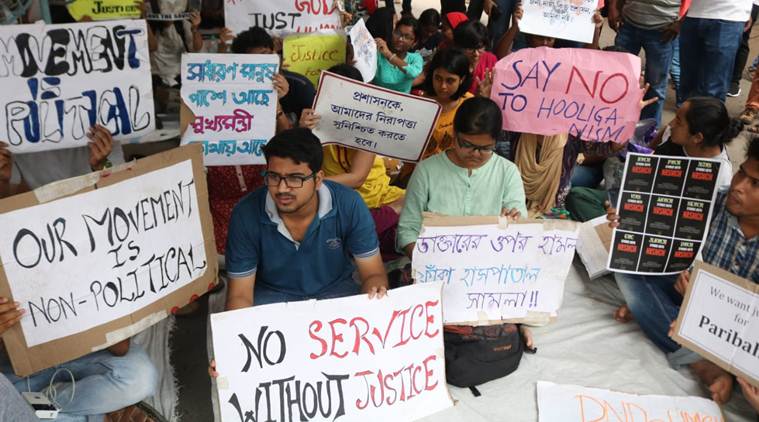
The recent assault on junior doctors in a medical college in Kolkata — that caused serious injuries to two interns — needs to be strongly condemned. Such violence is unique to the Indian Subcontinent. A number of studies have shown that violence at the workplace can have negative and disastrous effects on employee satisfaction and work performance. Having said that, doctors too are not completely innocent. It appears that the mob mentality has come to rule our social consciousness, preying on even the most elite members of the society. This needs deeper introspection by the society in general and the medical fraternity in particular. It is important to remember that we have institutionalised violence through politics, caste, religion, economics and gender discrimination. We have created a hierarchical social order through such institutionalised violence. Doctors are amongst those who sit at the top of this hierarchy.
Broadly speaking, India has two types of healthcare facilities — public and private. The latter delivers nearly 80 per cent of the country’s healthcare. Doctors in both public and the private sectors are at the receiving end of violence. The public sector is in general blamed for most of the faults of the services sector. We need to understand, therefore, why reactions are different when it comes to doctors.
Violence as a means of effecting “justice” is common in Indian society but a large part of the intellectual class, including doctors, remains insensitive to this problem, till they are affected. I have worked with some of the best minds in the profession. But I wonder how many of my seniors, colleagues and juniors would even know about the tombstones in India’s graveyard of injustice and violence. Most of my professional brethren haven’t even heard about the Khairlanji massacre, they don’t understand the reasons behind the Bhagalpur blindings, don’t care about what happened at Naroda Patiya and fail to understand the logic behind the Adivasi protests in Chhattisgarh’s forests. We doctors have an insulated existence, unaware of the institutionalised violence faced by common people. This is the most important reason for violence coming back to haunt doctors, painfully so. The young Indian doctor is angry at the injustice meted out to him/her without realising that Dalits, minorities, women and other underprivileged sections of Indian society suffer such violence on a regular basis.
Some may argue, correctly so, that injustices and tragedies should not be compared. But in the case of doctors, this argument does not hold much ground because doctors in India are considered next to god. Most doctors wear this idolisation with pride and this leads to hubris. The doctor-patient relationship in India is thus more than merely “professional”. The acceptance of this god-like status by Indian physicians is problematic, in fact, it works against them. Gods are not supposed to mint money and they are not supposed to have flaws. And, when they fall short of such standards of divinity, the illiterate and the deprived faithful unleash violence on them. India’s doctors should realise that their acceptance of a divine status makes them vulnerable to violence by patients.
The rampant corporatisation of medical practice and erosion of medical ethics in private and public set- ups is another reason for doctors facing the music. Corporatisation is known to have changed the behavioural patterns of healthcare personnel. Misbehaviour, over-treatment, under-treatment and blatantly over-priced treatment today constitutes an important part of the medical culture. Unfortunately, not many amongst us are willing to fight it. I am yet to read a statement by an authorised/statuary body of medicine or surgery in the country that condemns outright the malpractices of its members. Such hoodwinking goes on till coercion from the other side assumes threatening proportions.
The country’s medical fraternity, especially young doctors, should realise that we work with limitations of infrastructure. The poor conditions of government hospitals, particularly those in large parts of rural India, is no secret. Lack of proper infrastructure leads to improper care — this creates conditions rife for violence. With one
doctor for every 2,000 people, the situation is bound to get out of hand at times.
The working hours for residents, who form the backbone of public-funded healthcare, is dreadfully irrational but no one, not even the medical fraternity, wants to raise the issue with the administrative authorities concerned.
It would, therefore, be wrong for doctors, including those involved in the current agitation in West Bengal, to turn against patients. Their anger should be directed at the systemic failures, which leads to infrastructure shortage. The doctors should, in fact, send out the message that they are not against patients. A simple way to assert this point would be to run out-patient clinics outside their hospitals on days when they are on strike. Strikes by doctors can also be tricky from an ethical standpoint. It is correct to fight injustices but a doctor under the Hippocratic Oath is contractually obliged to care for the patient — this overrides all other responsibilities of a physician. Striking work complicates the issue in other ways too: Loss of public sympathy, brinkmanship of the administrators and demonising by the media erodes the moral standing of the doctors.
Solutions like beefing up security within hospital premises can only provide temporary relief. In contrast, sensitising a young doctor towards the problems of the poor and underprivileged can be a simple solution that could reap dividends in the long-run. Compassion, unfortunately, cannot be taught. Teaching behavioural sciences at undergraduate and post-graduate levels can be helpful. Acquainting the young doctor to social prejudices could also be a way to inculcate compassion. In other words, young physicians should be made aware that the violence they suffer incubates in the society they live in. Insensitivity to such violence makes one vulnerable to it.
Khan is professor of orthopaedics, AIIMS, New Delhi and author of Announcing the Monster, Views are personal